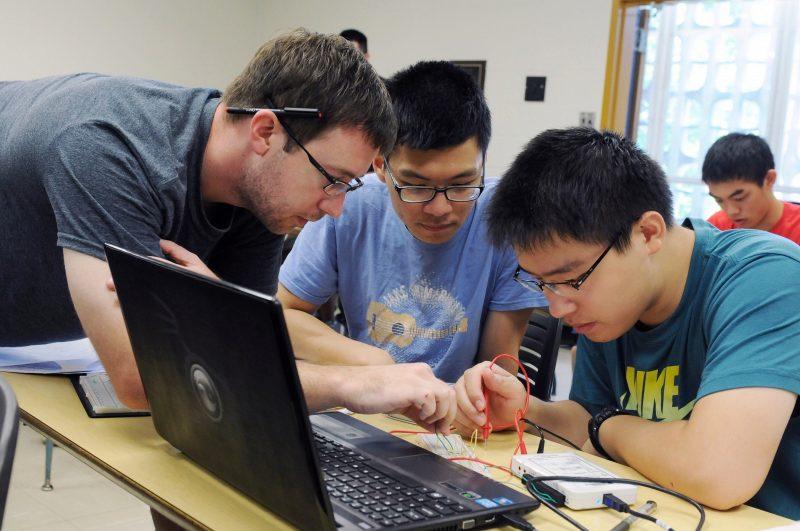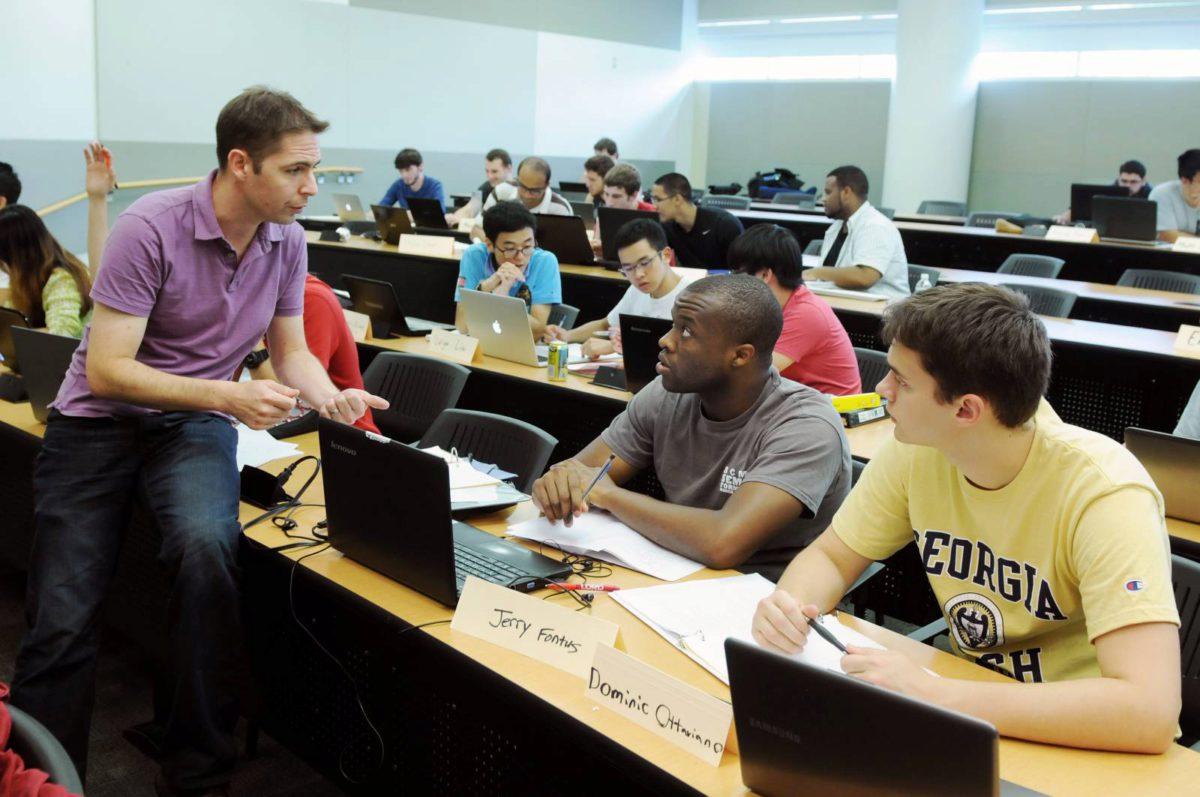
“Drownproofing,” Georgia Institute of Technology’s legendary and sometimes reviled tradition that taught swim coach Fred Lanoue’s water survival technique, has been gone from the curriculum since 1988. While Georgia Tech has always had a reputation for providing a world-class education, an interesting thought to ponder is “What is today’s version of Drownproofing?”
In recent years, executive leadership in the School of Electrical and Computer Engineering (ECE) has asked the questions “What life skills are we providing to current ECE students?” and “What is the best way to teach those skills?” One reason ECE’s Innovation in Education Committee was formed was to answer them. The committee, which is co-chaired by Bonnie Ferri, associate chair for undergraduate affairs, and Doug Williams, senior associate chair, has developed and launched innovative teaching methods that move ECE away from the traditional focus on what we teach to the broader framework of how we teach. The result is a curriculum emphasizing real-world application, teamwork, and creative problem solving that prepares students for the global workplace and gives them the confidence to impact the world. Following are some examples of leading-edge methods that ECE employs.
Hands-on Education
ECE is a leader on the Georgia Tech campus and among ECE departments across the country in integrating student-owned devices into lecture-based courses. The School’s curriculum includes eight classes that use either a digital acquisition board or a microcontroller kit, allowing students to work on projects and experiments any time and anywhere—from dorm rooms to classrooms. The result is improved learning of fundamental concepts and retention of information, as well as student confidence in their competency of the material. Almost 2,300 ECE students are involved in hands-on learning each year.
Flipped Classes
Lectures are delivered online with the class period dedicated to interactive and hands-on teaching. ECE leads the campus in the number of flipped classes and volume of students. The current ECE curriculum includes eight undergraduate courses and two graduate courses that follow this model and feature topics such as robotics, optics, circuits, and electromagnetics. ECE faculty members who have taught a flipped class are Bonnie Ferri, Vincent Mooney, Alenka Zajic, Morris Cohen, Magnus Egerstedt, Tom Gaylord, and Mary Ann Weitnauer.
Massive Open Online Courses
The School has successfully experimented with three Massive Open Online Courses (MOOCs): Linear Circuits, taught by Bonnie Ferri, Bruno Frasier, and Nathan Parrish; Introduction to Electronics, taught by Bonnie Ferri and Allen Robinson; and Control of Mobile Robots, taught by Magnus Egerstedt. Students from all over the world have signed up for these courses in impressive numbers. For example, the Linear Circuits course has just finished its third offering with a total of 42,000 student registrants, 400,000 completed homework problems, and more than a million lecture views.
Undergraduate Research
ECE offers undergraduate students a variety of ways to get involved in leading-edge research projects and gain hands-on experience to complement their studies. Individual or group projects can be short- or long-term and cover a wide range of student interests from NASA-sponsored rocket propelled vehicles to robots that play music alongside humans. Options for undergraduate research include:
- Opportunity Research Scholars Program (ORS)
- Vertically Integrated Projects (VIP) Program
- ECE's Undergraduate Research Opportunities Program (UROP)
- The Research Option in ECE
Online Learning Networks
The Intelligent Tutoring System (ITS) is an online question and answer system for concept practice that was developed by ECE Professor Jim McClellan and a team from the Vertically Integrated Projects (VIP) Program. It was first used in Introduction to Signal Processing (ECE-2025/6) in fall 2009 and quickly became an essential part of the homework assignments, providing more than 273 questions for practice. Since 2010, 1,732 students have used ITS in the course, and they have answered a total of 353,851 questions.
Piazza is a third party, online Q & A platform where students, TAs, and professors come together to learn and teach. Anyone can ask and answer questions on this community-edited platform. The platform is integrated with T-Square and enables students to do labs remotely, post pictures, and use the discussion forum to help each other.
Real-world Experience
Senior undergraduate students apply knowledge and skills from earlier coursework to solve real-world challenges in the two-semester Senior Design course sequence. Working in teams, students complete a project requiring specification, design, implementation, and testing. Projects are often multidisciplinary, allowing students to gain cross training in other engineering fields. The student teams’ efforts are showcased at an end-of-semester Capstone Design Expo, which is the largest in the country.
Entrepreneurial Confidence
In addition to preparing students to hit the ground running in industry, ECE also equips them with one of the most important life skills—the ability to create their own jobs. The ECE curriculum fosters entrepreneurial confidence.
- Center for Engineering and Technology Entrepreneurship (CREATE): An online map of campus entrepreneurship resources, courses, mentorships, and ECE startups.
- Startup Lab and Startup Summer courses teach students how to create a startup from customer discovery to developing a minimum viable product.
Ferri, who has been at the forefront of the School’s education innovations, says, “In today’s university system it’s easy for small departments to experiment with new forms of teaching, but what makes ECE’s work in this area so groundbreaking is our size. We are the largest producer of electrical and computer engineers in the country and we are using incredibly innovative methods at a huge scale. In fact, our faculty has been invited to speak in workshops all over the country to share our methods with peer institutions. I’m proud to be a part of a team that is changing the face of engineering education.”
Related Links
